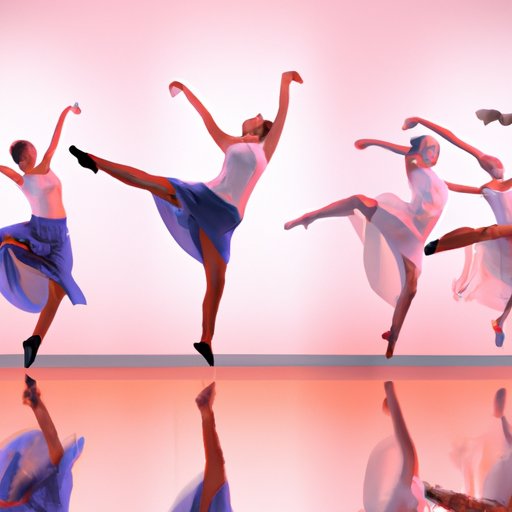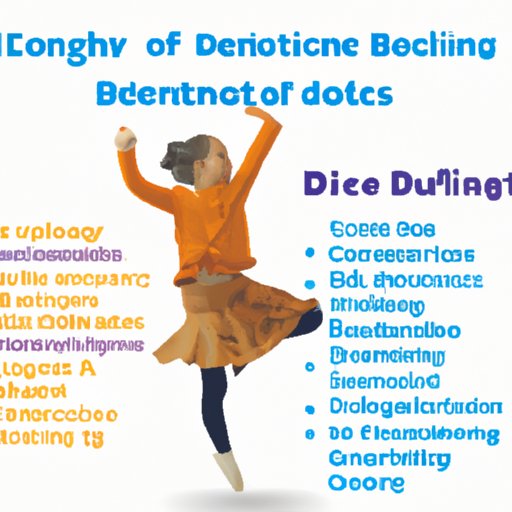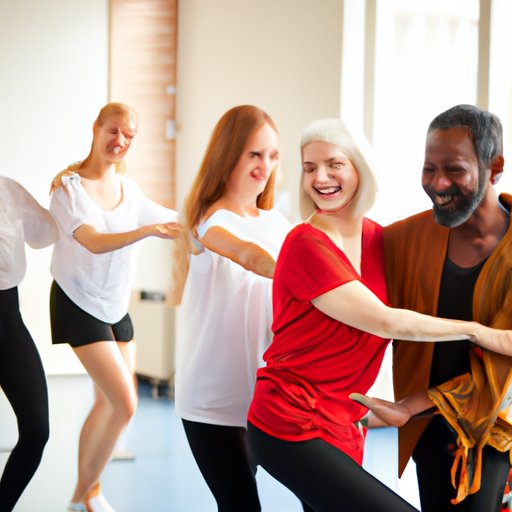Introduction
Dance is a form of art that has been around for centuries. It is a way to express oneself through movement and rhythm, and it can be done alone or with a group. In recent years, dancing has become increasingly popular as a form of exercise, due to its many physical, mental, cognitive, social and creative benefits. In this article, we will explore what dancing can do for your body and how it can improve your overall wellbeing.

The Physical Benefits of Dancing: How Dancing Improves Your Health
There are many physical benefits associated with dancing, which can help improve your overall health and fitness. Here are some of the most notable physical benefits of dancing:
Improved Cardiovascular Health
Dancing is an aerobic activity, which means it increases your heart rate and breathing rate. Regularly engaging in aerobic activities such as dancing can strengthen your heart and lungs, reduce your risk of heart disease, and lower your blood pressure. Additionally, aerobic activities like dancing can help you burn calories, which can aid in weight loss and maintenance.
Increased Strength and Flexibility
Dancing can also help to increase your strength and flexibility. The various moves involved in dancing require you to use different muscles and joints, which can help to build muscle and improve joint mobility. Additionally, dancing can help to improve your posture and balance, both of which are important for maintaining a healthy body.
Better Balance and Coordination
Dancing also helps to improve your balance and coordination. As you move your body in different ways, you must coordinate your movements and adjust to changes in tempo and direction. This helps to develop proprioception, which is the ability to sense where your body is in space. Improved balance and coordination can help to reduce the risk of falls and other accidents, especially in older adults.
Exploring the Mental and Emotional Benefits of Dance
In addition to the physical benefits of dancing, there are also many mental and emotional benefits. Here are some of the most notable mental and emotional benefits of dancing:
Stress Relief
Dancing can be a great way to relieve stress. Moving your body in the rhythm of the music can help to release endorphins, which are hormones that create feelings of happiness and relaxation. Additionally, dancing can help to distract you from any worries or anxieties, allowing you to focus on the present moment.
Improved Mood
Dancing can also help to improve your mood. When you dance, your body releases serotonin, which is a neurotransmitter that helps to regulate mood. Additionally, dancing can help to boost your self-esteem and give you a sense of accomplishment, which can further improve your mood.
Enhanced Self-Confidence
Finally, dancing can help to increase your self-confidence. As you practice and become more proficient at dancing, you will gain a sense of pride and accomplishment. This can help to boost your self-confidence and make you feel more comfortable in social situations.

The Cognitive Benefits of Dance and Learning
Dancing can also have cognitive benefits, which can help to improve learning and academic performance. Here are some of the cognitive benefits of dancing:
Improved Memory
Dancing can help to improve your memory. Learning the steps and sequences of a dance routine requires you to remember and recall information, which can help to strengthen your memory. Additionally, the rhythm of the music can help to create associations between different pieces of information, making them easier to remember.
Stimulated Brain Activity
Dancing can also stimulate brain activity. As you engage in different types of movement, your brain must process and interpret this information, which can help to increase your cognitive functioning. Additionally, dancing can increase blood flow to the brain, which can further improve your cognitive functioning.
Improved Concentration
Finally, dancing can help to improve your concentration. When you are dancing, you must focus on the movements and rhythms, which can help to increase your ability to concentrate on tasks. Additionally, dancing can provide a form of distraction, which can help you to focus on the task at hand and avoid being distracted by other thoughts or activities.

The Social Benefits of Dance: How Dance Strengthens Relationships
In addition to the physical, mental, and cognitive benefits of dancing, there are also social benefits. Here are some of the social benefits of dancing:
Improved Interpersonal Communication
Dancing can help to improve interpersonal communication. As you interact with others while dancing, you must communicate nonverbally, which can help to strengthen your communication skills. Additionally, dancing with others can help to foster positive relationships, which can further improve your communication skills.
Positive Social Connections
Dancing can also help to create positive social connections. Dancing with others can help to build trust and understanding, which can lead to stronger relationships. Additionally, dancing in a group setting can help to create a sense of belonging, which can further strengthen social connections.
Increased Teamwork Skills
Finally, dancing can help to increase teamwork skills. When you are dancing with others, you must work together to create a unified performance. This can help to improve your ability to collaborate and work together with others, which can be beneficial in both professional and personal settings.
The Creative Benefits of Dance: How Dance Enhances Creativity
In addition to the physical, mental, cognitive, and social benefits of dancing, there are also creative benefits. Here are some of the creative benefits of dancing:
Increased Imagination
Dancing can help to increase your imagination. As you learn new dances and choreography, you must think creatively in order to come up with new moves and combinations. This can help to stimulate your imagination and can be beneficial in other areas such as writing, painting, and other forms of creative expression.
Enhanced Problem-Solving Abilities
Dancing can also help to enhance your problem-solving abilities. As you learn new dances and choreography, you must think critically in order to figure out how to combine the moves and create a cohesive performance. This can help to improve your analytical and problem-solving skills, which can be beneficial in other areas of life.
Improved Expression of Feelings
Finally, dancing can help to improve your expression of feelings. As you move your body in the rhythm of the music, you can express emotions that might otherwise be difficult to put into words. This can help to improve your communication skills and can be beneficial in both personal and professional settings.
Conclusion
As you can see, dance has numerous physical, mental, cognitive, social and creative benefits that can enhance overall wellbeing. From improved cardiovascular health and increased strength and flexibility to improved memory and enhanced problem-solving abilities, dance can do wonders for your body.
(Note: Is this article not meeting your expectations? Do you have knowledge or insights to share? Unlock new opportunities and expand your reach by joining our authors team. Click Registration to join us and share your expertise with our readers.)
